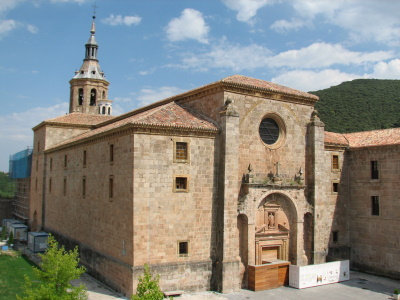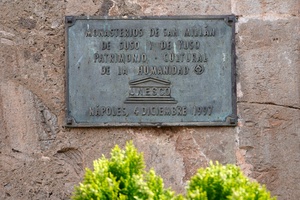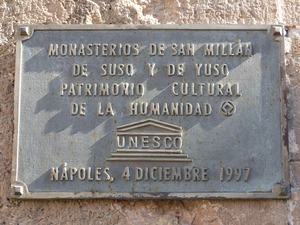Yuso and Suso Monasteries

The San Millán Yuso and Suso Monasteries are early Christian monasteries known for their role in the development of the Spanish language.
The holy man Millán settled here in the 6th century, was joined by other eremitic monks and a Romanesque church was built on the spot. Suso is the oldest of the two monasteries, and it is the site where phrases in the Spanish and Basque languages were written for the first time. This codex was subsequently preserved in the 16th-century monastery library at Yuso.
Community Perspective: Expect to see many books on your guided tour of Yuso, while what’s left of Suso is one small church. A shuttle bus runs between the two monasteries. You can stay overnight at Yuso as well.


Map of Yuso and Suso Monasteries
Community Reviews
Caspar Dechmann

I visited this site in 2006 when I didn't think a lot about WHSs yet and hadn't seen many sites. Even then we found it surprising if not ridiculous that this site should be a WHS. The site consists obviously of two sites: Suso the upper monastery is tiny but has a certain charme with visigothic and mozarabic elements that I would certainly appreciate today though they have hardly any OUV on their own. Yuso, the lower monastery, on the other hand, lacks any special character or beauty. There are dozens of more interesting monasteries in Spain alone.
Even in the nomination the claim for fame does not mainly refer to the architecture: "It was here that the first literature was produced in Castilian, from which one of the most widely spoken languages in the world today is derived". and: "The Spanish language, a principal work of human creativity, was born, in both spoken and written forms and in both prose and verse, within the eremitic communities of San Millan". I think this accumulates several strange assumptions: The fact that the oldest preserved written sentences of Castilian are found here does not prove that this language was created here or even written down for the first time. And to call Spanisch a "principal work of human creativity" is hard to believe. It is one of many Latin dialects and as such not more valuable then any other Roman language. That fact that it was later spread around have of the globe doesn't make it more creative or ingenious then any other language. Or we should have at least one site per country concerned with the birth of a language. We see, even then the arguments for inscription were sometimes humbug.
The camino francés is really a treasure trove for romanesque and early gothic architecture. If you travel there Yuso and Suso is an easy and short visit but certainly not a highlight.
Clyde

I visited this WHS in August 2014. After some reading and research I decided to concentrate my visit mostly on the Yuso Monastery which is the bigger one of the two. It costs 6 euros to visit and we were accompanied by a Spanish guide throughout the visit. A leaflet in English containing the gist of what she says in Spanish is handed out but it isn't really all that necessary. The Yuso monastery houses the first verses written in the Castillian language so it is an important national cultural site apart from being a WHS. The church cloister and gilded furniture are nothing out of the ordinary compared to other WHS I've seen. The sacristy though is beautiful. The Books of Gregorian Chant weighing up to 80kg were the highlight of my visit. Two treasures worth seeing are the boxes/chests decorated with the original 12th century ivory plates of San Millan intricately carved and in very good condition. The exterior is worth a quick photo mostly for the serene environment surrounding the Yuso monastery. The Suso Monastery is very small compared to the Yuso Monastery and there is a shuttle bus that takes you there and back every 15 minutes departing from in front of the Yuso Monastery. Entrance tickets (inclusive of shuttle bus service) are sold at the Yuso Monastery. I enjoyed my visit as another stopping point on my return road trip from Portugal but it's definitely not one of Spain's best WHS in my opinion.
sally herbert
My husband and I are, at present, staying in the Yuso hostelerie. We have done the tour and visited Suso this morning. We walked back through the woods glimpsing deer on the way.
It is Sunday. Staying in a monastery we looked forward to daily Mass and special celebration today but no............. we will have to go to the chapel in the village since no mass is said in church - at least not for visitors. What a terrible waste of resources.Such atmosphere, such history and the centre of it all ignored!
John booth

The village of San Millan de la Congolla was picturesque and set in an amazing landscape.
I reached it by a bus that travels there in the afternoon from Logrono via Najera, and returns in the evening allowing several hours for a visit to the Yuso and Suso monasteries.
I found the displays of the earliest books in the Castillian language in the Yuso monastery very interesting. Because the bus to Suso was not operating on the day of my visit I hiked up the hill through the forest to see this ancient building.
Els Slots

Yuso Monastery is an impressive complex when you first arrive. And popular with the tourists as well. Entrance is only via a guided tour, which costs 4 EUR. The tour (with ca. 40 people) lasts about an hour. It’s a tiring affair for non-Spanish speakers, as the guide will stop often for long talks. It will take you through all the important rooms, however. Especially the Sacristy is a feast of paintings, furniture, frescoes and a golden altar. The church is under restoration at the moment, and all the decorations are packed in a paper (as if the artist Christo had stopped by).
Yuso’s older sister, Suso, is located uphill. When you’ve bought a ticket, a bus will take you there to go on a guided tour. What’s left of Suso is only the church. So it’s only one room, quite tiny. This guide also starts a long story before we can enter the building. No photos are allowed inside, but this is not strictly reinforced. The interior is almost empty, except for graves. What I liked most was the medieval graffiti on the outside of the building.
I stayed overnight in the ‘Hosteria del Monasterio de San Millan’, which is located in a wing of the Yuso Monastery. It’s one of our ‘Hotels in Historic Buildings’! The long hallways give it away that you’re in a monastery. I guess the hotel is quite new, the room at 60 EUR was pretty modern and luxurious (it has a bath, minibar and Wifi!).
The hotel restaurant gets a definite thumbs down on Tripadvisor, and also their breakfast is overpriced at 11 EUR. So I skipped both and only stayed for the night. The village of San Millan does have at least two other restaurants at the central square, which seem to be open while the tourists are there (until 7 p.m.). I ate a good value menu at the more upscale restaurant of the two.
Community Rating
- : Inigo Cia Luisfreire Thomas Harold Watson Van Hung Scubarrie
- : Alexander Lehmann Antonio J.
- : Juropa Thibault Magnien Christravelblog Voyager Zhenjun Liu PabloNorte Kevin247
- : Craig Harder GeorgeIng61 Philipp Peterer Tarquinio_Superbo Jeanne OGrady MH Napalm Bruno_Pires Els Slots
- : Awestix Clyde Dorejd Shandos Cleaver Xiquinho Silva Jean Lecaillon Jezza Echwel Walter CeeMon Viaje al Patrimonio Stanislaw Warwas
- : Zoë Sheng Mikko Randi Thomsen Svein Elias Ivan Rucek Hubert Mike Little Lauren Travels Javier Argo
- : Solivagant Joyce van Soest Luboang Daniel C-Hazard Juha Sjoeblom Adolfo
- : Philipp Leu Csaba Nováczky Wojciech Fedoruk
- : Caspar Dechmann
Site Info
Site History
1997 Inscribed
Site Links
Connections
The site has 16 connections
Art and Architecture
Constructions
Human Activity
Religion and Belief
Science and Technology
Timeline
Trivia
Visiting conditions
WHS Hotspots
WHS Names
WHS on Other Lists
World Heritage Process
Visitors
162 Community Members have visited.
The Plaque
 (photo by Hubert)
(photo by Hubert) (photo by Clyde)
(photo by Clyde)